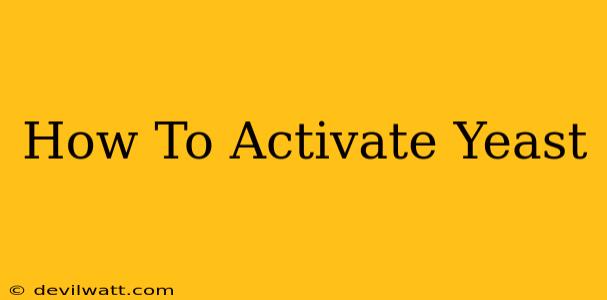Activating yeast, also known as proofing yeast, is a crucial step in baking that ensures your bread, pastries, and other baked goods rise beautifully. Without properly activated yeast, your baked goods will be flat and dense, far from the light and airy texture you desire. This comprehensive guide will walk you through the different methods of activating yeast, helping you achieve baking success every time.
Understanding Yeast Activation
Yeast is a living organism, a single-celled fungus that feeds on sugars and produces carbon dioxide as a byproduct. This carbon dioxide is what creates the air pockets in your dough, leading to that desirable rise. Before it can do its job, however, the yeast needs to be "woken up" – this is yeast activation. The process involves providing the yeast with the right environment: warmth, moisture, and food.
Why Activate Yeast?
Activating yeast isn't just a matter of following a recipe; it's essential for:
- Ensuring Yeast Viability: Not all yeast packets are created equal. Activating your yeast allows you to check its viability before investing time and ingredients in your recipe. If the yeast doesn't activate, you'll know to use a fresh packet.
- Consistent Rise: Proper activation ensures a consistent and reliable rise, resulting in perfectly textured baked goods.
- Improved Flavor Development: Active yeast contributes to the development of flavor compounds during fermentation.
Methods for Activating Yeast
There are several methods to activate yeast, each with its own advantages:
1. The Warm Water Method (Most Common)
This is the most straightforward method and works well for most yeast types, including active dry yeast and instant yeast.
-
What you'll need:
- 1 cup warm water (105-115°F or 40-46°C) - Too hot and you'll kill the yeast; too cold and it won't activate. Use a thermometer to ensure accuracy.
- 2 ¼ teaspoons (1 packet) active dry yeast or 2 teaspoons instant yeast
- 1 teaspoon sugar (optional, but helps activate the yeast faster)
-
Instructions:
- Add the warm water to a large bowl.
- Stir in the sugar (if using).
- Sprinkle the yeast over the water. Don't stir it in immediately. Let it sit for 5-10 minutes.
- Look for frothy activity: The mixture should become foamy and bubbly. This indicates that the yeast is alive and active. If it doesn't foam, your yeast may be dead or the water too hot or cold. Try again with fresh yeast.
- Once activated, proceed with your recipe, adding the yeast mixture to your dough.
2. The "Sponge" Method (For Flavor Development)
This method involves creating a pre-ferment, or sponge, which allows for longer fermentation and enhanced flavor development.
- Procedure: Mix a portion of the flour, water, and yeast from your recipe together, and let it sit for a few hours or even overnight. This creates a bubbly sponge that is then incorporated into the final dough. This method is particularly beneficial for sourdough and artisan breads.
3. Direct Addition Method (Instant Yeast Only)
Instant yeast doesn't require separate activation. You can add it directly to the dry ingredients of your recipe. However, ensure the water you are adding is the correct temperature.
Troubleshooting Yeast Activation Problems
- No activity: Your yeast might be old or the water temperature incorrect. Try again with fresh yeast and a thermometer to check water temperature.
- Too much activity: The water might be too warm. Allow the yeast mixture to cool slightly before proceeding.
Conclusion: Mastering Yeast Activation
Successfully activating yeast is fundamental to achieving great results in baking. By following these methods and troubleshooting tips, you'll be well on your way to creating delicious, light, and airy baked goods. Remember to always use a fresh packet of yeast for the best results! Happy baking!

